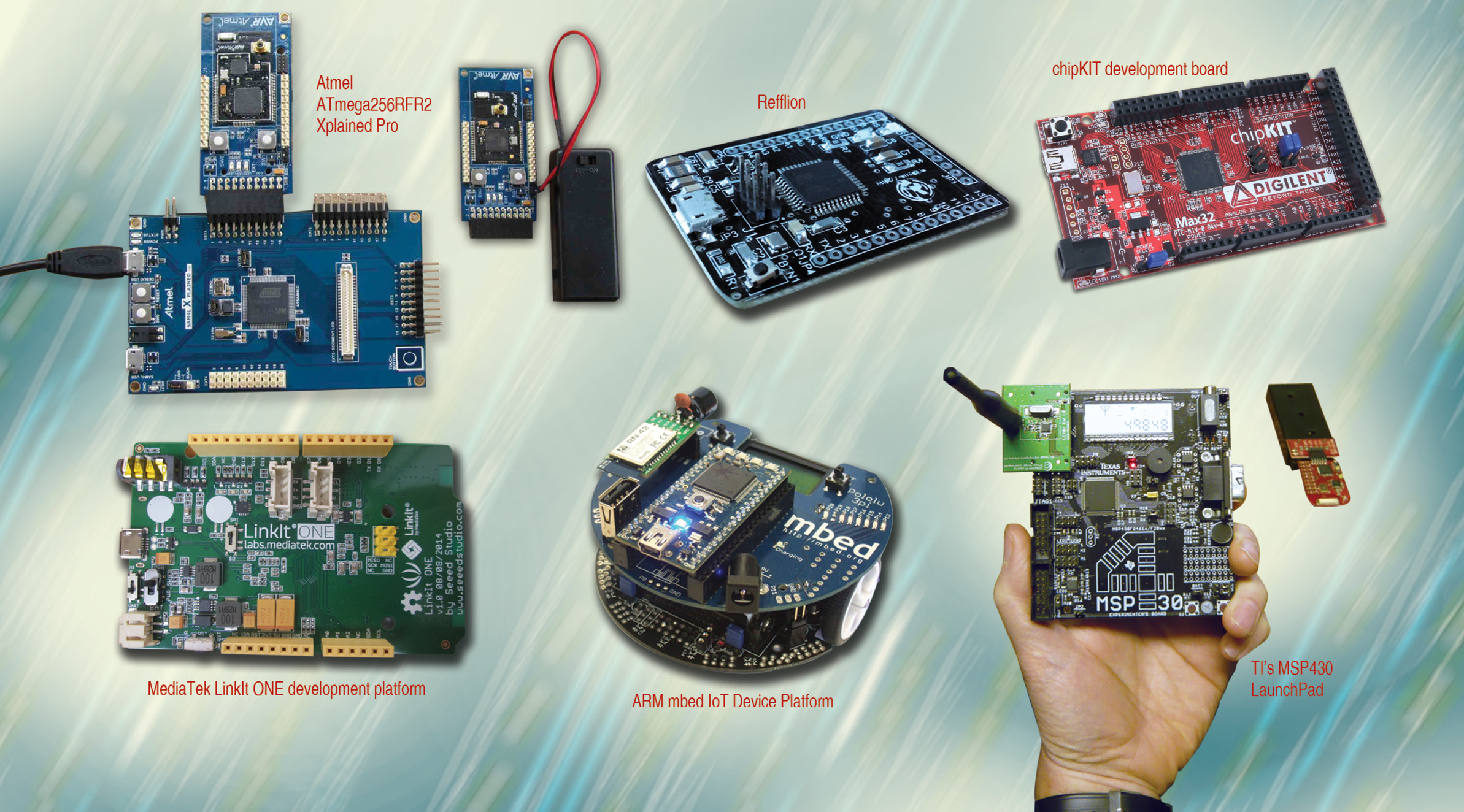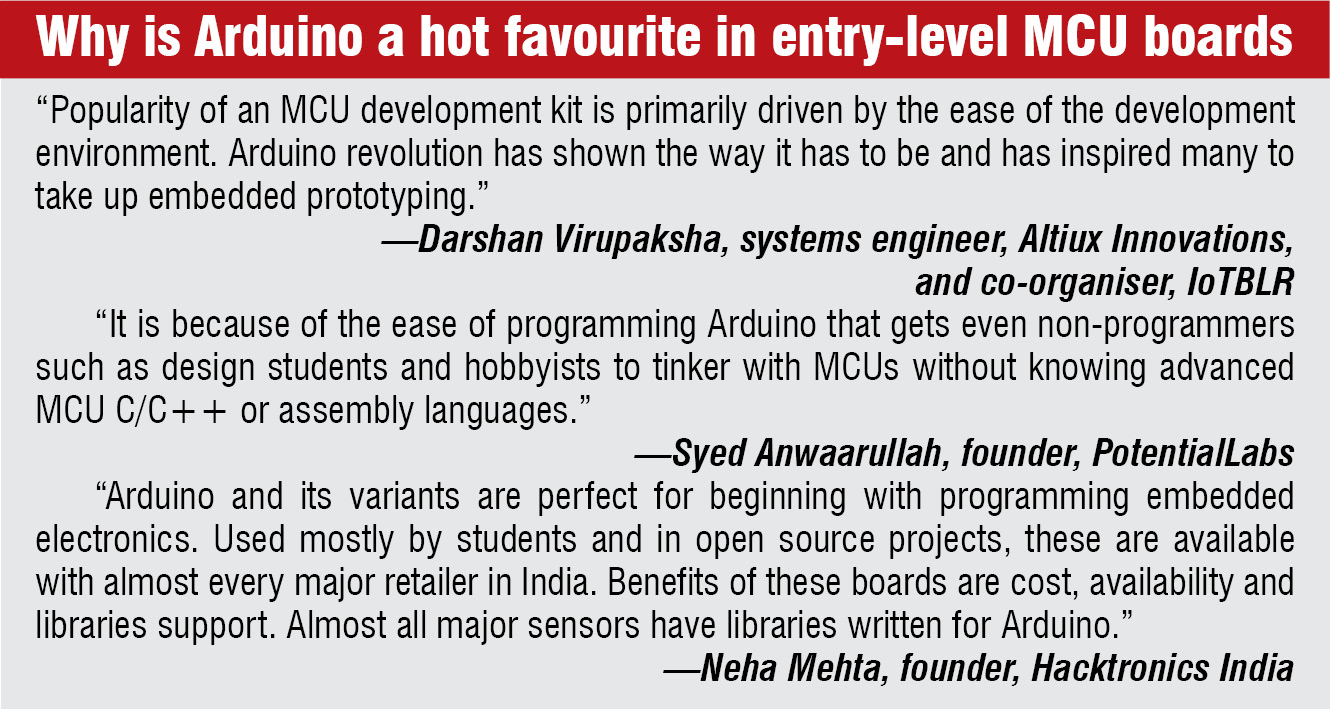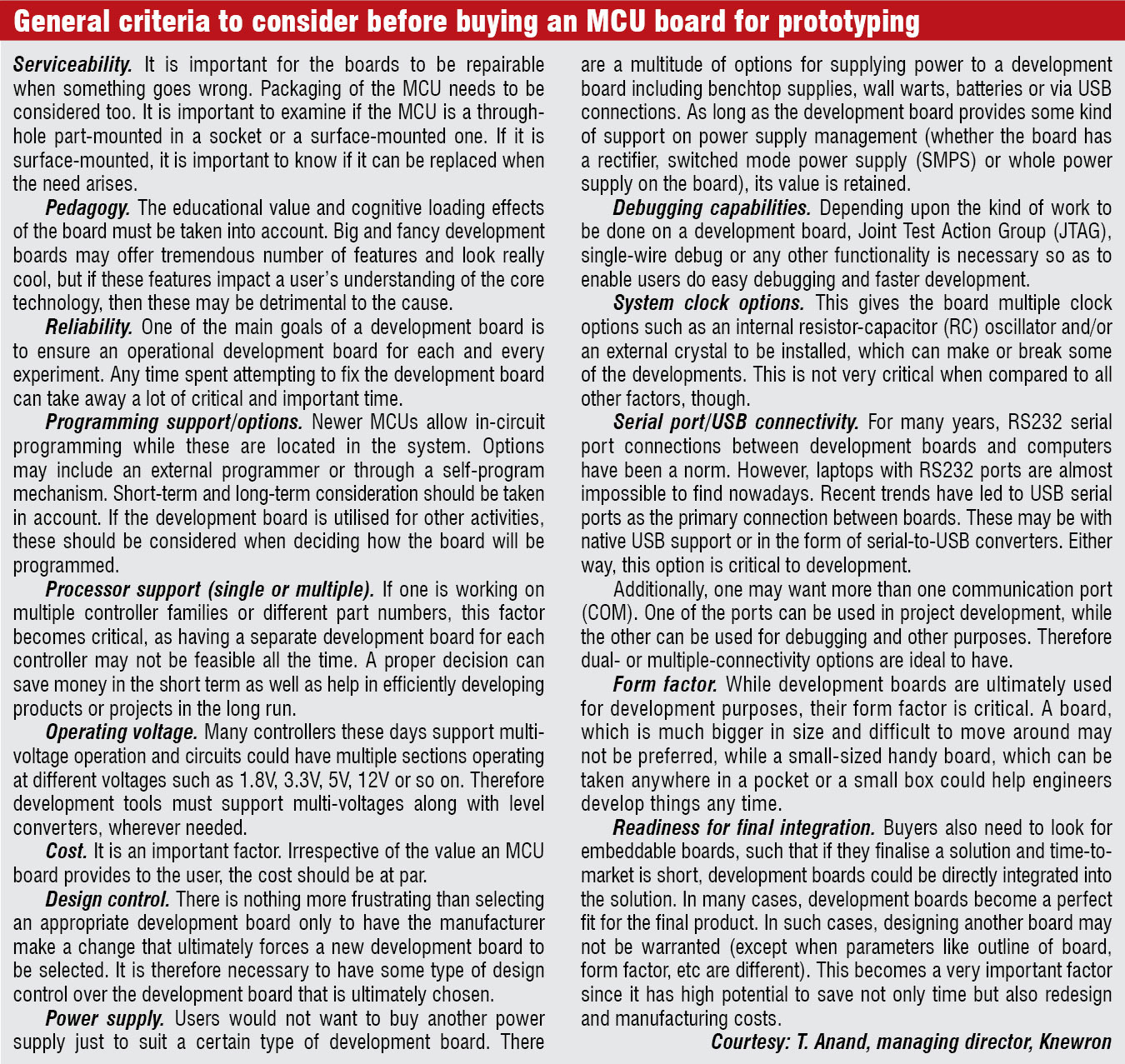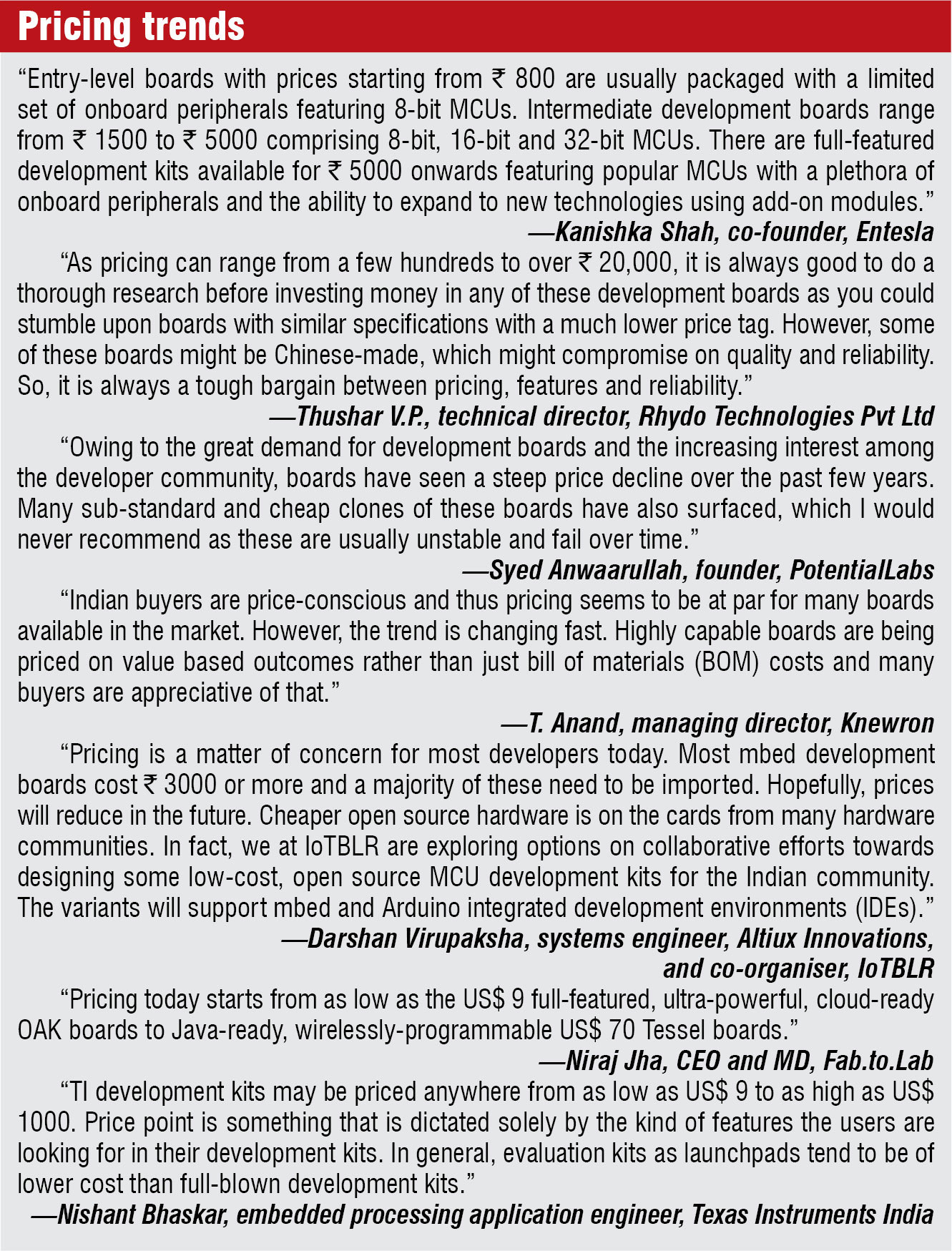“Embedded design prototyping has never been so easy before,” exclaims Darshan Virupaksha, systems engineer, Altiux Innovations, and co-organiser, IoTBLR. He says, “Makers and do-it-yourself (DIY) enthusiasts have a plethora of options to suit their needs. Today, the ecosystem offers easy access to development boards and the most important feature is software support.”
The prototyping scenario has indeed seen an escalation and one of the biggest factors is the range of microcontroller (MCU) development boards out there in market. From low-cost, entry-level boards to powerful, application-specific ones, we try to help you buy the right board by focusing on different categories, new features, general selection criteria and boards that have been in the spotlight.
General, application- and industrial-specific boards
Quite a few development boards in the market today are general MCU-specific, such as STM32 discovery kits, MSP430 from Texas Instruments (TI) or Xplained boards from Atmel, and these are available from semiconductor manufacturers themselves, informs T. Anand, managing director, Knewron.
Local companies design some of the economically available boards. Anand says, “In both cases, MCU development boards come in two flavours; one is the MCU evaluation board, where the focus is on evaluating MCU capabilities.”

“Second category is application- or feature-specific, where the board is designed for the purpose of evaluating certain features of the MCU and is usually focussed on some application area,” he adds.
Broadly, there are three different categories that today’s MCU boards fall under.
Generic multi-purpose boards. Today, every MCU manufacturer like Microchip, NXP, Cypress, TI and Atmel provides an evaluation kit compatible with their MCUs. Kanishka Shah, co-founder of Entesla, says, “International third-party development board manufacturers like Arduino, Sparkfun, Adafruit, Seeedstudio and Mikroelectronika are popular among students, hobbyists and professionals for the quick prototyping tools they offer.”
Shah adds, “Development boards for MCUs based on AVR, PIC, 8051 and ARM7 architectures are very popular among students and beginners as these are easily available in the local market. These come with a varying set of onboard peripherals to suit a wide range of applications for every budget.”
These can be used for rapid prototyping and smaller proof-of-concept (POC) development. “Boards such as Arduino, MangoPi, chipKIT, mbed, MSP430 Launchpads and STM32 discovery kits, to name a few, fall under this category,” notes Syed Anwaarullah, founder, PotentialLabs.
He adds, “MCU development platforms such as Arduino come with a host of free and open source libraries that help in building rapid prototypes very easily with the help of add-on shields and expansion boards.”

Application-specific development boards. Anwaarullah informs that, such boards are for dedicated tasks mostly used by companies or engineers building specific products in areas such as home/industrial automation, automotive applications and more. He says, “These development kits allow to rapidly test the functionality of the MCU as per requirements before moving on to fabricating custom printed circuit boards (PCBs).” Such boards are usually costly in comparison to generic development boards, but offer more features and a dedicated development tool chain.
Platforms like Raspberry Pi (or Raspi), BeagleBone and mbed have very high processing power running into GHz and random access memory (RAM) that expends in GBs, remarks Neha Mehta, founder, Hacktronics India. She says, “These boards run custom Linux variants and encapsulate all complexities of the external hardware into friendly programming languages like Python, for instance.”
Industry-ready development boards. Advanced processing power boards based on ARM7 or ARM9 architecture are used for industrial applications. “These include Cubietruck boards and dual-core or quad-core processors-powered Allwinner boards, which are mostly used for media processing in applications like smart televisions, media centres and digital video recorders (DVRs).”
Such boards can be used directly in real-time applications. Anwaarullah says, “For instance, Arduino Micro or Pro Mini are compact enough to be embedded inside products directly and can also be programmed on-the-go as requirements change.”
Features in the spotlight
Different MCUs have varying features and the entire development board is usually based on the supported features of the MCU. Thushar V.P., technical director, Rhydo Technologies (P) Ltd, says, “Nowadays, many development boards such as Raspi or BeagleBone support an onboard operating system (OS). Though a great feature, these boards tend to be more expensive than the ones without an onboard OS.”
Primarily, one does look at MCU boards for their processing and memory capabilities, but nowadays most of these offer decent RAM and flash capabilities, remarks Virupaksha. He says, “This makes interface [like serial peripheral interface (SPI) and Inter-IC (I2C)] and out-of-box support offered more valuable.” He adds, “Many chips now also support a universal serial bus (USB) natively and sometimes USB host as well.”
Features such as availability of embedded wireless modules, dedicated functionality such as encryption and data logging, over-the-air (OTA) programming and mobile/cloud synchronisation are some new features to look out for, observes Anwaarullah.

ARM, with its mbed initiative, has helped programmers to have a variety of mbed-enabled boards using MCU chips from most of the ARM licencees like NXP, STMicroelectronics and Freescale, among others, notes Virupaksha. “A rich variety of features in terms of input/output (I/O) peripherals, low-power modes and hardware accelerator for digital signal processing (DSP) plus security-coupled software support make the development process a joyful ride with the latest development boards.”
Another addition to this exciting lot is Java-/Java script-enabled boards. Virupaksha adds, “Knowledge of Embedded C is no more a limitation. Traditional Java programmers can now code on MCUs. Java source code is compiled using cross compilers and programmed on to the target device.” Other higher level languages like .net are supported too. Espruino development kit can be programmed using Java scripts and Netduino using .net.
Kits featuring graphic liquid crystal displays (LCDs), thin-film transistor (TFT) displays and communication ports with onboard transceivers are popular among users. “Many users also look for onboard sensors, which may be as simple as the ones for sensing the X-Y-Z coordinate and as complicated as the ones that perform medical applications like pulse oximetry,” notes Nishant Bhaskar, embedded processing application engineer, Texas Instruments India.
He adds, “In case of power electronics based systems, customers not only look for the extent to which the power stage has been designed but also the configurability on offer, if users want to tweak it.”
Another very important feature in present-day development boards from companies like STMicroelectronics and TI is onboard debugging, informs Virupaksha. He says, “Apart from beginners, most users require this feature. In fact, it is a boon for developers, as they need not invest in a debugger, which costs approximately Rs. 8000.”
Even with all these new features, Thushar feels, basic I/O pins, universal synchronous asynchronous receiver transmitters (USARTs), serial peripheral interface (SPI), I2C, two-wire serial interface (TWI), timers, compare/capture/pulse width modulation (CCP), analogue-to-digital converters (ADCs) and digital-to-analogue converters (DACs) constitute basic features of an MCU, which should always be accounted for as far as a development board is concerned.
With increased focus on smartphone based connected applications, consumers also prefer to work with wireless MCU kits [specifically in the Wi-Fi/Bluetooth Low Energy (BLE)/Bluetooth domain], which have some kind of Android or iOS app to interact with, informs Bhaskar. He says, “Some customers also prefer to have access to the source files of these graphical user interfaces (GUIs)/apps as reference for their own development.”
For developing IoT applications
The rapid growth of Internet of Things (IoT) applications requires devices to be connected to the Web. Niraj Jha, CEO and MD, Fab.to.Lab, says, “Most people would like to have an Ethernet port or a Wi-Fi module built into the board.” The biggest feature to consider for developing IoT-related products is inbuilt connectivity.
Mehta says, “It is important to consider the kind of connectivity options supported by the MCU like BLE4.0, 2.4GHz wireless technology and others.”
Another important feature is the ease of programming while using the board. Programming becomes much easier if the board can run Linux or Android. “For smaller processors, I would choose a processor architecture that is well-supported and has tons of documentation available online,” states Mehta.
She adds, “Companies like STMicroelectronics and TI provide their own software development kits (SDKs), which wrap all internal hardware-level details for that particular MCU and make it easier to upgrade to a newer processor based on the same architecture.”

Additional onboard features like flash-to-store program, lithium battery charger and SD card support are good to have.
“Last, power consumption and different sleep modes are essential. It is important to consider environmental factors such as adaptability of the board in remote locations running on solar power, or if it can survive on a small battery during unavailability of power for long durations.”
Since the IoT is the talk of the town, Jha feels, some users might also want specific features like a display, motor/servo control for Internet-connected robotics applications or sometimes a combination of a relay built into an IoT-ready board for home automation applications. He says, “Boards specifically made for home automation sometimes have other niche features like mesh networking built in. Other IoT boards may have features like secured cloud connectivity built-in into its software as well.”
New technologies, prospects
ARM Cortex-M architecture based MCUs seem to be the future, feels Virupaksha. He says, “Getting used to ARM MCU architecture will be an added advantage for any career prospect.” He adds, “Also, mbed today has revolutionised the development environment by making it an online compiler. You just need a computer and an mbed board to get started.”
As such no new revolutionary technology has emerged in the last few years, but according to Moore’s Law, the speed is always increasing, notes Mehta. She says, “Intel has launched many new development boards like Galileo and Edison, which take the leverage of Intel’s powerful and trusted platform.”
Mehta adds, “Most technologies used are old like Wi-Fi but are packaged into newer processors and at highly reduced costs like the ESP8266 chip, which can act as a Wi-Fi solution with an integrated MCU. Older chips like AR9331 are packaged as easy-to-use modules like Onion Omega and Domino Pi boards, which cost around US$ 10, have integrated Wi-Fi stacks and can run embedded Linux.”
With an increasing requirement for ultra low power and data reliability, Bhaskar feels, ferroelectric random access memory (FRAM) is slowly being seen as a viable replacement for flash. FRAM offers a huge number of read/write cycles, with lesser read/write times and much lower power consumption as opposed to flash. He says, “These kinds of devices are useful in particular for applications that have very stringent requirements on power consumption.”
He adds, “TI also features a whole host of development kits, both general-purpose as well as application-specific, based on our FRAM MCUs for users to evaluate.”
Developers should also look for development boards integrated with onboard features for different wireless technologies like Wi-Fi, Bluetooth, Global System for Mobile communication (GSM), General Packet Radio Service (GRPS), ZigBee and near field communication (NFC) with a low-power MCU and display, opines Shah.
He says, “The ability to interface different low-power technology sensors like accelerometers, gyroscopes, global positioning systems (GPSes), temperature and humidity sensors using add-ons should be made available onboard in future.”

Boards in the spotlight and some upcoming ones
A new US$ 9 board called Chip has recently received more than US$ 2 million in online crowd-funding, informs Anwaarullah. He says, “This is a power-packed board that comes with onboard Wi-Fi, Bluetooth and an ARM processor. At such a low price, building powerful connected devices and scalable solutions becomes a lot easier.” This board, which starts shipping by 2016, will create endless possibilities.
MediaTek LinkIt ONE development platform is one among the best, feels Virupaksha. He says, “It enables you to design and prototype wearables and IoT devices, using hardware and application programming interfaces (API) that are similar to those offered for Arduino boards.” He adds, “It is a power pack in terms of its features as it offers Bluetooth, GSM and GPS on a single platform and, most importantly, in a very small form factor.”
Raspi recently sold two million boards and is a very good board for learning basic computer programming and interfacing with hardware. Mehta says, “Apart from Raspi, we are seeing high traction for Wi-Fi boards with ESP8266 or AR9331 chipsets.”
“mbed has been making quite some noise with its Cortex M0 and Cortex M3 based NXP MCU development boards supporting cloud based firmware development,” says Shah. He adds, “Launchpad series by TI is quite popular among developers working on low-power battery-operated devices based on MSP430.”
BLE sensor tag based on CC2541 has garnered a lot of attention ever since it was released. It has won EE Times/EDN Ace award for the best development kit and was also announced as the first Bluetooth Smart accessory to support Android (July 2013). Bhaskar says, “This design kit, while being extremely low-cost (about US$ 25), has been extremely popular with users over the years for IoT based solution development.”
Similarly, CC3200 Launchpad has been of great interest among users looking to add Wi-Fi based connectivity to their embedded applications. Bhaskar says, “CC3200 has been an award-winning chipset, receiving several accolades in 2014 such as Electronics Products Product of the Year, Zinnov Innovation Award and Electronic Design Best Communication Product of the Year.”
Arduino Zero definitely provides a huge boost to the community and provides a powerful MCU with Arduino IDE support, which makes it merrier to implement some complex projects, informs Virupaksha. He says, “Many crowd-funded boards using Nordic Semiconductor’s nRF51822 have helped many BLE developers to demonstrate use cases with mobile phones and other IoT applications.”
Keeping in mind the requirements of building scalable IoT applications, Anwaarullah says, “Our team has built an Arduino-compatible Wi-Fi IoT development board called Refflion for building end-to-end IoT solutions through cloud gateway and mobile applications.” Made in India, Refflion can also be used by educational organisations and universities to introduce students to build connected robotics, wearables and other IoT solutions. He says, “Refflion will soon be launched internationally on crowd funding, and backers would be able to get the board and shields at a special price.
Knewron’s Quickly is an IoT-ready development board, which has all the essentials required to develop IoT-related products. Anand says, “Alpha version of the board is already available for sampling, and beta version is coming out in July. This was also featured in EFY Expo 2015 held at New Delhi.”







